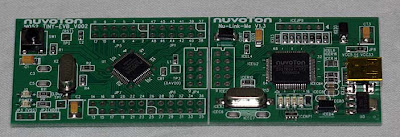Here is a comparison of specifications of multiple ARM processors.


| Technologic Systems TS-7260 | Olimex LPC-L2294 | Nuvoton Learning Board Nu-LB-NUC140 | Tiny Nu Nuvoton M051 SDK | LPCXpresso LPC1769 Embedded Artist | Mbed LPC1768 Embedded Artist | |
| Photo |  |
 |
 |
 |
 |
 |
| Processor | ARM9 | LPC 2294 ARM7TDMI (NXP) | ARM Cortex M0 (Nuvoton) | ARM Cortex M0 (Nuvoton) | Cortex M3 ARM LPC1769 (NXP) | ARM Cortex M3 (NXP) |
| Clock | 200 MHz | 60MHz | 50MHz | 50 MHz | 120 MHz | 100 MHz |
| On Chip RAM | - | 16KB | 16KB | 4 KB SRAM | 64 KB | 64 KB |
| On Chip Flash | - | 256KB | 128KB | 64KB of program 4KB data |
512 KB | 512 KB |
| On Board RAM | 32 MB | 8 MB SRAM | - | - | - | - |
| On Board Flash | 32 MB | 4 MB | - | - | - | - |
| On Chip Oscillator | - | - | Yes | Yes | Yes | Yes |
| On Board Crystal | 14.74 MHz | 14.7456 MHz | 12MHz, 32kHz | 12MHz | 12 MHz | 12 MHz |
| Price | USD 179 | EUR 115.95 (Ref ) | USD 119.7 (digikey) | USD 19.95 (digikey) | EUR 20 | EUR 45 |
| Free Compiler & IDE | GCC | GCC (WinARM) | Keil (max 32KB) | Keil (max 32 KB) | Code Red, max 128KB code | onlinehttp://mbed.org/ |
| Ethernet | 10/100 on board | 10/100 on board | - | - | 10/100 ethernet connector by adding | 10/100 ethernet connector by adding |
| In Circuit Emulator | ? | available with special JTAG devices | Yes | Yes | Yes | Yes |
| Operating System | Linux | FreeRTOS | CooCox & FreeRTOS |
CooCox | ||
| Power Supply | 4.5V ~ 20V with on board regulator | 4.5VAC / 6 VDC with on board regulator | 5V via USB or connector | 5V via USB | 5V via USB or 3.15V-3.3V DC | Via USB 5V or 4.5V ~ 9V DC |




